Disclosure: TheParadiddler.com received this product free of charge for review purposes. However, TheParadiddler.com is not compensated in any way for sales of said product. We recommend that you do your own independent research before purchasing anything. Of course, since my business rests completely on my reputation, I can’t afford to recommend anything that isn’t fantastic quality. – Omar Alvarado, The Paradiddler
Double bass drummers have it good. I’m not talking about players that use a double bass pedal on a single bass drum, but those that use two bass drums. Why so?
The bass drum, for obvious reasons, is the most visually pronounced drum of the kit. Since the resonant head faces the audience, many single bass drum drummers place a logo there for all to see, making it even more pronounced.
That being the case, the drummer wants that drum to be facing straight to the audience. It just looks cool! But this leads to a slight disadvantage.
The drummer is automatically slightly off center. (For the purposes of this discussion, I’ll be referring to right-handed double pedal players, but the mirror-opposite applies to lefties as well). Since the bass drum is facing straight ahead, the drummer has to veer slightly towards the left to make sure the right foot (and leg) is at the proper angle for bass drum play. This presents a slight ergonomic challenge, particularly if the drummer has more hardware on their right side. Whereas the higher toms are more readily accessible (since you’re practically facing them), more ‘contorting’ is required to reach the lower toms, and possibly cymbals as well.
Back to the double bass drum player (again, two bass drums, not one drum with the double pedal). If you notice, this drummer is perfectly centered for drumming. He (or she) is facing directly ahead. The two bass drums are conveniently placed at an angle comfortable for the drummer’s legs and feet. The snare drum is directly in front of them, and toms right ahead. Since they’re more centrally situated, they can more easily reach both sides of their kit without too much ‘contorting’, as it were, especially referring to the lower toms.
This does not necessarily mean that the double pedal drummer, or even the single pedal, single bass drummer is not comfortable, per se. It simply means that by necessity the drummer is off center, and it results in more adjustments needed as far as optimum posturing for effectively reaching every part of the kit, particularly the right side.
In the DVD review of Matt Ritter’s “Unburying the Beater”, it was discussed that Matt had come up with a solution for this slightly ‘off center’ issue: forget the notion that the bass drum is the center of the kit. In doing so, he went on to explain the ideal posture and positioning behind your kit. He mentioned that you, the drummer, should face your audience. When you sit on the throne, the angle that your legs comfortably position themselves in, resulting in something like an equilateral triangular stance, are where the bass drum and hi-hat stand should go (where the feet comfortably end up).
There’s more detail regarding this that Mr. Ritter goes into, but the bottom line is that setting up your kit this way makes you play in a more center-like stance.
However, although the above takes care of your positioning, you still have the issue of playing slightly off center in relation to the kit. The more equipment you have on your right side, the more difficult it may be to comfortably reach them. This is an inherent disadvantage of the single bass drum setup.
So the question then becomes: is there a way for the single bass drum, double pedal player to enjoy the same benefits that the double bass drum player enjoys, as far as playing ‘on center’, as it were? The answer is yes: enter the Off-Set double bass pedal.
The premise of the Off-Set double pedal is that the drummer of the single bass drum kit should be centered behind the kit just like the double bass drum player is. The typical double bass pedal has both beaters on the right side, which displaces the drummer to the left. The Off-Set double pedal has both beaters in the middle, with the left and right pedal on either side of the bass drum, mimicking the double bass drum setup. This allows the drummer to sit squarely behind the kit, with the bass drum and snare right in front.
This now also makes for a shift to the left of the kit (or a shift to the right of the drummer, however you want to look at it), which means the drummer now has easier access to the right side of the kit (less contorting).
For comparison’s sake, let’s compare the Vex Pro Touring Double Bass Pedal (of “Instructional Video – Vex Pro Touring Double Bass Pedal (Round Two)” fame), a typically designed double bass pedal, to the Off-Set double bass pedal. Here’s a picture of them together:
Notice the obvious difference of the position of the beaters. The Vex pedal represents the typical double pedal configuration; the Off-Set pedal mimics a double bass configuration. Now we’ll look at both pedals installed on the bass drum:
Now we’re starting to see how the typical pedal off-centers the drummer to the left, while the Off-Set pedal places both pedals on either side of the bass drum, keeping the drummer centered.
The next two pics will show the drummer’s legs from behind, with the Vex pedals installed, and then with the Off-Set pedals:
From this angle, you can see that for the typical double pedal, the drummer’s feet, and hence the rest of his body, is forced to play off-center (the bass drum being ‘pushed’ to the right). With the Off-Set pedal, however, the drummer’s feet are on either side of the bass drum, hence they’re squarely behind it – on center!
The following picture illustrates what I call the ‘baseball effect’:
In baseball it is widely accepted that the best teams are the ones that are the best down the center: center fielder, shortstop/second baseman, pitcher, and catcher. If your best players are at these positions, your team has a better chance of winning more games than not.
The same is true for drumming! The picture above shows the bass drum (center field), the two toms (shortstop and second base), the snare (the catcher), and the throne, which represents you, the drummer, as the pitcher. A beautiful thing when it’s all in a row! If you are centered as a drummer, with a proper equilateral stance, with your equipment evenly surrounding you, you will be a better player, because you’re positioned to play better. The typical double pedal shifts the drummer to the left, making for off-center playing, and not the optimum positioning.
Now let’s look at a drummer* in action with the two pedals, and compare the stances. Here are two pics with the drummer playing with the Vex pedals, and then with the Off-Set pedals:
In both pics, the drummer is playing his ride cymbal. In the Vex setup, he’s positioned more towards the left, so to reach the cymbal he has to accommodate for the distance. But in the Off-Set setup, it’s simply a matter of the position of the arm; the torso stays in place. Also the right-mounted tom and the floor tom are more easily accessible.
The latter point may be better illustrated with a top view of both setups. Take a look at the following pics:
The drummer is playing his floor tom. With Vex pedals, it is more of a reach to play the floor tom because more turning is required to reach them. But with the Off-Set pedals, less turning is required to reach the floor tom. If you have yet another floor tom, then reaching them with the typical double pedal configuration starts to be a strain; but with the Off-Set pedals centering you behind your kit, it is more easily reached.
Of course, it is all a matter of positioning. The drummer with the typical double pedal will set up his kit (if he’s properly versed) in a way that is optimum for them. But if the same drummer used the Off-Set pedal, then they would be perfectly centered, and arranging the kit becomes easier, ergonomically speaking. Equipment on both sides of the kit is equally reachable. You are now the center of your drum kit, instead of one of the pieces of the kit (usually the bass drum). That alone, plus the feeling of complete balance, might be the most important aspect of effective and efficient drum play.
Ok, so we’ve extolled the practical aspects of the Off-Set double pedal, but how about the pedal itself? In a word: fantastic!
This is a professional quality pedal, with quality components, and made to last. Right out of the box I could see that the foot boards were huge— 3.5”x12.5”— one of the largest, if not the largest in the industry. This allows for any style of play, be it heel up, or heel down, or a combination. The spring-loaded anti-skid spurs and anti-skid pads on both pedal base and center beater housing ensures that the pedals and center housing will remain solidly in place throughout the playing session.
Since this is not your typical pedal, it is strongly recommended that you follow the instructions included in the box to assemble and adjust the pedals. You don’t want to take these out of the box for the first time right at your next gig, or you may get a little frustrated! Better play with the configuration beforehand. It’s not complicated, just different.
And speaking of configuring, there are so many ways to configure the pedals that it’s ridiculous. I had mentioned in the aforementioned Vex instructional video that for the typical double bass pedal, you will never get both pedals to feel exactly the same. Virtually the same, possibly; exactly the same, no. However, the Off-Set pedals are bi-laterally symmetrical, meaning both sides can be configured exactly the same.
Both pedals have exactly the same components for adjustability:
- Radius adjustable drive wheel – the only pedal in the industry on which the diameter of the drive wheel can be infinitely adjusted from 1.5” to 3” with only a drum key
- Fully adjustable concentric double chain drive
- Quad drive springs for increased response and sensitivity
- Completely independently adjustable beater holders with 1” lateral adjustment each
- Independently height-adjustable pedal boards
- Center-mounting hoop clamp which eliminates all lateral torque on the bass drum hoop
- Eliminates hip displacement and joint stresses caused by traditional placement of the standard pedals
- Extremely ergonomic drum-centering design
The above lists the main features (plus a couple more) that allow each pedal to be configured exactly how you want for each foot. With so much configurability, you can:
- Configure each pedal to be exactly the same
- Configure one pedal to feel heavier than the other
- Configure one pedal to be faster than the other
- Move one pedal closer or farther away from you than the other
- Move one or both pedals farther away from the central housing
- Adjust the height of a pedal totally independent of the beater
- Adjust the distance of the beater from the bass drum head totally independent of the pedal
- Angle each pedal according to the exact orientation of your foot
I could not do so much configuring with any other pedal I’ve seen. I did try at first to attach the pedals without reading the instructions first. I attached the pedal, but it definitely didn’t feel right. So I resigned myself to follow the included instructions, and it actually was fun discovering all the different configurations. After a little tweaking, I tried playing them again, and at first it was a little weird because I wasn’t used to being (and feeling!) so centered. It was very comfortable, and the pedals are so responsive. I beat away at them for a bit, and then decided to adjust the springs for a little more resistance (there are two springs per pedal, and the knobs are big for easy adjusting), and I was flying. I’ve tried out several pedals, but these not only felt at least as good as any I’ve played with before (or tested out), but the feeling of playing in the middle, whether psychological, or physiological, or both, made me play with more confidence.
As far as the sound of the bass drum itself, it is interesting to note that neither beater will hit the bass drum head exactly in the middle. Although that might sound like a negative, it really isn’t since both beaters are hitting the head symmetrically in relation to each other, so they both will sound exactly the same, the way it should be!
Now I’m a fan of double bass play, so I’m very excited about this pedal. However, I realize that there are drummers that are just not double bass players, and probably never will be. Off-Set also has available a single pedal model, both for righty and lefty drummers, that have the same characteristics of the double pedal. Again, they allow you to be centered and provide for optimum comfort and accessibility to your whole kit.
There’s a lot more information at the Off-Set web site that is of great interest that you will want to look up, such as:
- The history of how the idea came to Charles Fisher,+ creator of the Off-Set pedal
- Additional photos and details on the solid construction and patented design of the pedals
- The medical benefits of the Off-Set pedal vs. the typical double pedal
- Other double pedal models and related products, including, for example, different sized drive rods
The pedals currently can be had for $339.99, factory direct from Off-Set. There are several top of the line double pedals by other manufacturers that sell for over twice as much. But so far, my feeling is that this pedal trumps them all. Because it’s not just the quality of the pedals physically (which these are as good as any), but it’s the unique bi-lateral symmetric design, virtually unlimited configuration possibilities, and the ability to play fully centered and balanced behind your kit that make this pedal a winner in the pedal industry. I very rarely, if ever, give a perfect ten out of ten paradiddles for a product, but the Off-Set double pedal comes very, very close.
The Paradiddler’s Implementation of the Off-Set Double Bass Pedal
_____________
*A very special thanks to my son Devin for doing a fine job as the model drummer
+To read the insightful interview The Paradiddler conducted with Charles Fisher, click here.
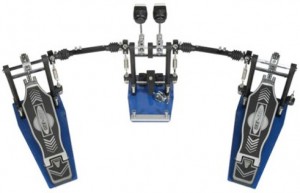
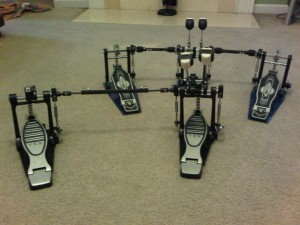
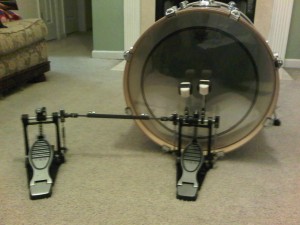
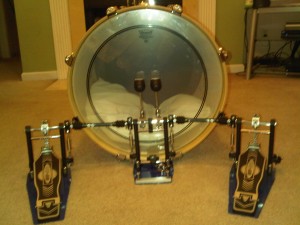
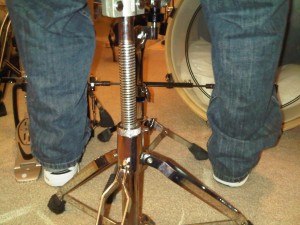
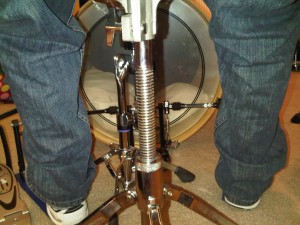
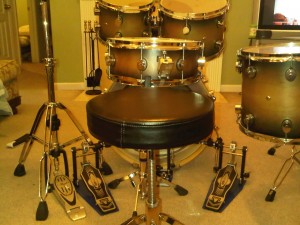
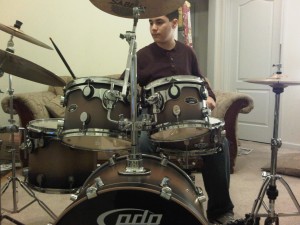
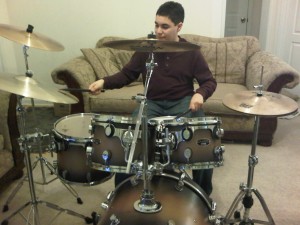

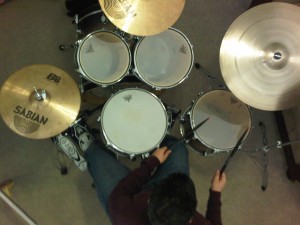
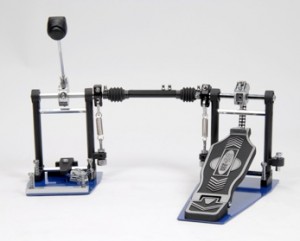
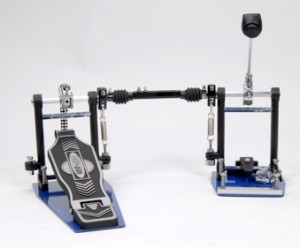
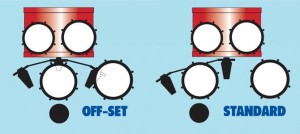
 All rights reserved.
All rights reserved.
{ 35 comments… read them below or add one }
Hi Omar,
I now these post are old now but hope you can reply. What I am interested in doing is also having a hi hat in the centre of my snare. I could achieve this with this pedal if the linkages were long enough to move the bass drum forward to get out of the way off the remote hat stand ( I will put the tons on either side of the hats). So my question is how far do do linkages extend and in practal terms how far can I then move the bass drum away from me. Hope the makes sense!
Thanks
Hey Mick. Glad to hear from you!
I would contact the Off-set.net folks and see if they can provide for you a custom-size drive rod to accommodate the length you’re looking for. You can explain to them what you’re trying to do, and they can let you know if they can accommodate you. If you pull this off, I’d love to see a picture!
OA
Mick, and Omar
I have been on a quest to redefine the kit in a balanced way: Hi hat directly at 12 o’clock to the snare, using a cable hat, and a floor tom on either side. Currently using the same Iron Cobra’s I’ve used for 20+ years, but thinking I could get my RH floor tom further to the front of me if the corner of the kick drum wasn’t in the way.
Did you wind up trying out the Off-set and if so how did it work for you, with regards to the centered placement of hi hats? Did you have to have special parts made to make it work?
Thanks!
~Ryan
Hi folks,
Is this type of pedal available in the UK? I can only seem to find it abroad. How much do they cost from Off-Set?
Hi Tony.
You can e-mail info@off-set.net with that inquiry. 🙂
it’s awesome!!!!
i want to buy it.. but where i can get the double pedal?
You can go directly to the Off-Set web site to purchase directly from the manufacturer.
Came across your site reading the review of the offset double pedal. Very interesting and many actually get one of them. I wanted to invite you to check out the Desert Drummer, that’s me. Aside from the My Space page that I listed also check out: http://www.youtube.com/user/Xenophanes18 as you’ll see that I’m a big fan of tribal drumming.
Uh – simple way around this issue… Buy a free standing tom mount stand? Place your ride over the ‘off-centre’ kick and you have the same ergonomics as provided by the pedal described above.
Hey Rhys.
The Off-Set pedal aims to mimic the ‘centered’ feeling that a double bass drum player experiences. That you won’t get from the typical double bass pedal. The configuration you mention is correct and will work, except now you’re off-center again. 🙂
As mentioned in the article, it’s a matter of ergonomics, and many drummers have obviously made good with the typical double bass pedal. But many drummers also rave about the Off-Set pedal and how it makes them feel behind the kit, and they become fans for life. Plus, the pedal itself is pretty good! 🙂
Thanks for your comment!
What a lot of people don’t seem to realize is that if you’re using a double bass pedal, you set up as if you have two bass drums. You’re not “off centered”, everything stays the same, it’s just that you don’t have another kick to lug around or worry if it’s tuned to the other kick. Having the bass dead in front of you is throwing every thing off. Now you have to sit further back so that there’s room for the snare, and the riding tom that was to the left (R.H. drummers) of the snare is now on the right of the snare. This doesn’t put you any closer to your ride cymbal. If you had to over reach for the ride cymbal it was in the wrong place to begin with. As with any kit or equipment, it has to be set up so that the player is comfortable playing it and can easily reach all the components. I’m not saying this is a bad product, lots of people will probably be happy with this, but some will see it as a gimmick (I personally prefer the Janus Transmission hi-hat/ double bass pedal, which many saw as a gimmick). What I am saying, however, is that most of what you have written here is misinformation that most experienced drummers will see through and disavow and that’s not helping the product any. I’ve been a professional drummer for over 40 years. Check out “Pissed at Ringo” on YouTube.
Thanks for commenting Mugsy! Much appreciated.
You make some valid points. The typical double bass pedal configuration has been around forever now, and drummers will accomodate the rest of their kit to suit them, regardless. It may be more of a frame of mind than ergonomics, but in the end, it’s what the drummer feels comfortable with, and that’s what really matters (check out the drum configuration in the video “Jack White – Steady, As She Goes (Live at Hackney 2012)“). Many fans of the Off-Set pedal certainly don’t think it’s a gimmick, based on many of the comments here, and yours truly. I for one feel ‘centered’ behind my kit with this pedal, and I’ve arranged my kit based on that ‘feel’, and it works for me, even though I’m making adjustments all the time (the OCD in me). The Sleishman double bass pedal has a similar configuration, and Will Calhoun of Living Colour is a fan of that pedal.
I do stand by everything in the review as valid and not misinformation, so I’ll respectfully disagree with you there. 🙂 Will I ever use the typical double bass pedal again? Certainly! Will it require moving stuff around? Certainly again, but isn’t that the fun of it?
I purchased my Off-Set Pedals 3 yrs ago and they’re the best investment I’ve ever made in kick drum pedals. I can’t go back to the regular double pedals out there, just wouldn’t feel right. The mallets they come with aren’t bad either however they’re my backups since I prefer to use Slug beaters as my primary beaters. I LOVE MY OFF-SET PEDALS!
Yo bro, funny how everything in your paragraph is exactly like I woulda worded it. Got mine 3yrs ago and I too use slug beaters and I can’t go back to regular double pedals either. I’ve always considered regular double pedals to be offset and the “Off Set” pedals to be perfectly centered, go figure.
Where can I buy an offset double pedal???
Hey Austin.
The pedal can only be ordered direct from the company. Go to the Off-Set Bass Drum Pedal Company web site. At the top of the page, click on the “Ordering Info” link. You’ll find the instructions for ordering there. 🙂
Wow! I was just telling my wife about this double pedal I had seen recently, where the beaters were in the center. Since I am the lead singer for my band this would allow me to face the audience and be seen better while singing. And here it is.
I am going to try it out and hopefully if it has a great main right foot feel and strength, then I’m sold. I’ll let you all know asap. 🙂
Hey Rob,
Please let us know how it goes! It never occurred to me that this type of pedal suits the singing drummer very well.
Good luck!
While I think the pedals are cool… I disagree with the setup scenario. Just like the above poster. I am centered on my kit. True my body might be twisted from the crowd… but on the kit everything is right in front. I also have toms to the left of the kick. It really depends on how you setup your kit. Not everyone is sitting at a twisted position.
Hi Larry.
The setup scenario mentioned in the article is actually what I encountered with my kit. I have both my toms mounted on my on my kick (because the kick has a tom holder), so my toms were not directly in front of me. One option, of course, was to buy a stand so I could mount the toms on them instead of on the kick (maybe that’s how you have them). But there’s no question that when I installed the Off-Set pedals, I was now squarely behind my kit, and felt more comfortable. As I quoted for PJ, drummers adapt to the equipment they have, especially over time. That’s a good thing! If you can, though, I encourage you to try the Off-Set pedals sometime. I have, and I think they’re great!
I agree they would be perfect if I set up toms directly on kick like you do. I just don’t have a need for something like that with my setup.
I am curious to the feel and speed of the pedal. How long is the footboard?
I moved around my toms since my last reply to see if they would work for me, and it would feel more comfortable when toms are on kick.
I am in the market for a new pedal…a matter of fact was going to buy a new one today. $339 isn’t bad at all. How long have you played on yours?
Hey Larry.
The footboard is one of the longest (if not the longest) in the industry.
If you haven’t already, I encourage you to read the interview with Charles Fisher, the creator of the pedal. Very insightful and informative.
As for me, I’ve been playing on them since the beginning of this year (2010). They do take a little getting used to, since we’ve been exposed so much to the typical pedal configuration, but I now love how centered and balanced I feel. Plus, the pedals are very configurable, and they feel very responsive as well. My last two drum covers feature this pedal.
They have a 7-day money back guarantee so you can try them. If you decide on them, let us know how it goes!
Hey Larry, if you do not agree that the offset pedals are the greatest in the world, then Omar will not get off your back. I think he gets paid to promote these pedals regardless of how much you think you DON’T need them. Have a nice day!
Hi antonio.
Just a few things!
1. Larry does not have to agree that they are the greatest pedals in the world
2. I’m not, and have never been, on Larry’s back
3. Read the disclaimer at the beginning of the review
Have a nice day (no really, have a nice day)! 🙂
Here’s a few links to some of my YouTube videos. I must admit that maybe I jumped the gun on the set-up, I went back and reviewed some of my stuff and low and behold…it’s noticeable how everything is off-set. The reason I now say its “square” is because my bass is off-set, not the rest of the set.
It also depends on how big the kit is too. I have added enough pads to surround myself almost evenly on both sides so it “seems” square but (true to your words), the bass is off-set still.
For me its playability and nothing to do with showmanship so it doesn’t matter if the bass is canted some, as long as I can still comfortably work my way around the kit, the universe is cool!!!
If you copy and paste in the address bar you should see the videos. Later taters : )
http://www.youtube.com/watch?v=eghxy8CWGqQ
http://www.youtube.com/watch?v=TkFi7nZTFEA
Hi PJ.
Duly noted! I saw your videos. The second video is actually another good demonstration of the bass drum being off-set to the right. What a coincidence that you had that video from that angle (you’ll have to tell us how you did that!). I do see your point about your drums being spread out around you. Yes, it’s all about comfort and playability. Someday you may want to try the Off-Set pedal though – it’s a trip!
By the way, your videos are way cool. Keep it up!
NOT TRUE AT ALL!!!
I in fact use the Vex and have a 100% “square” set-up and have the snare comfortably between my legs. I play both sides of my kit and have had electric, acoustic, single bass, double bass, single bass w/single pedal and single bass w/dbl pedal.
It appears that the photos are exaggerated to make the point.
Hi PJ.
Thanks for your comment! I love it when readers present different viewpoints.
I went back and looked at the photos, and I’m going to respectfully disagree with your observation. The photos are not exaggerated. The Off-Set pedals force you (in a good way) to sit squarely centered behind your bass drum. That is the main concept and benefit of the Off-Set pedal. With the typical double bass pedal, the drummer is ‘off-set’ to the right or left. That is a fact.
The photos are for illustrative purposes only. Of course, not every drummer is the same. Every drummer will figure out (eventually, if they stick to it) what their optimum placement should be behind the kit, even with the typical double pedal. However, note this comment from the Off-Set review: “Of course, it is all a matter of positioning. The drummer with the typical double pedal will set up his kit (if he’s properly versed) in a way that is optimum for them. But if the same drummer used the Off-Set pedal, then they would be perfectly centered, and arranging the kit becomes easier, ergonomically speaking. Equipment on both sides of the kit is equally reachable. You are now the center of your drum kit, instead of one of the pieces of the kit (usually the bass drum). That alone, plus the feeling of complete balance, might be the most important aspect of effective and efficient drum play.”
As far as your setup, I’d love to see it! Do you have photos, maybe ‘bird’s-eye’ view, with you sitting at the kit, and the like? It’s always educational to see how others have their kits set up; it can help others get ideas for their own setups.
Stay tuned to TheParadiddler.com, because there will be a lot more information coming regarding these pedals, and you’ll find it very informative, I promise you! And thanks for reading the article, and for your comment!
The Paradiddler
🙂
Great review and a whole bunch of food for thought on drum positioning. I play a single kick pedal, however like having the two up in the shortstop and second base position as you have described it. To accomplish this I have the mounted toms off of the kick with the ride hovering over the kick drum. I think of my kick pedal, hi-hat pedal and toms as the three sides to a triangle with the throne at one point. If you cut-copy-paste this URL you can see the birds eye view of my set up. http://i910.photobucket.com/albums/ac302/areFish/Drum%20Pictures/IMG_0056.jpg
One weak link for me in my set up is the distance between my middle and floor tom. The comfort of play between the snare and two mounted toms is improved over the standard set up in my case however.
My drum set positioning has changed since I posted 3 months ago. Here is a driver’s seat pic of my current set-up.
http://i910.photobucket.com/albums/ac302/areFish/Drum%20Pictures/IMG_0814.jpg
Sunday!
Very nice. Can you tell us how you came up with the new configuration?
I wanted to try a one-up, two-down configuration. Not having two floor toms I positioned a rack tom in a FT position by clamping it to a cymbal stand. The drums are all relatively low and flat, which I like. It is a slight twist to get to the actual FT, but I’ve adapted to it. I also removed the rack tom mount from the kick drum and installed a custom made cover plate.
Para – Great review. I have been a double “kicker” for 40 years and just recently made the jump to a Roland TD10 (single kick of course). I spent 2 months combing through reviews on all of the double pedals out there and came across your review on the off-set. It took a little bit more of me looking around that I realized that this is the perfect pedal. I bought one; it is truly the best pedal I have played.
Excellent write up.
THANKS!
Greg
Nice write up Omar – a good read with some well though out points. The concept of having a standard set up kick NOT facing directly at the audience is one that I also suggest in the Stick Technique book – you probably remember. When I saw Mat Ritter’s DVD suggesting the same thing I was pleased – by the way – to all out there who have not yet seen it – get it – it is a good dvd. This pedal may not be for all drummers I think, but it is certainly an innovative concept and I think that it will find a permanent place in the set up of many drummers. I myself have reservations about double kick in general – not that it’s bad – I always encourage as much work with feet as hands and good double kick technique is a very worthwhile pursuit. What I often see in many drummers though is an underdevelopment of each foot as they learn to rely on two feet to achieve some of the patterns that can in fact be played with one after some development. The problem with using two feet on the bass drums is that it neglects the high hat which is actually the most expressive instrument on the kit with a greater sound palete than any other. The question of erganomics with kit set up has always been a biggy and I’m quite sure that for many drummers this pedal will indeed improve their positioning. I feel that it is certainly a worthy addition to the selection of tools drummers have to create their art.
All the best mate and keep up the good work
Jim McCarthy
Para—good job with the write-up and showing the differences between the two double bass pedals. I wholeheartedly agree with everything discussed. When I first started playing some 30 years ago, there were no mass production dbl pedals. Certainly not advertised. My first kit was a dbl bass Rogers–two 20’s– and they felt fine and that’s how I learned to play. I have always been a big fan of double bass. But yes, you do have to be comfortable or the additional stresses will wear on you. I currently have two kits that can be seen on Harmony Central’s site–“show us your kits”–pages 208 and again at 211. One kit is a 6pc Bop kit with an 18″ bass but I place it on the left side using a lefty dbl pedal. It allows me to place all my toms lower and closer to my right side and even allows me to drop my ride cymbal as well. I will probably play this kit for quite some time. The ONLY problem I would see with the centered pedal is on my other kit I have two 24″ Slingerland basses and that would STILL keep my toms mounted up pretty high. Other than that, great pedal, great idea, and again, great article. Thanks–daveconaway